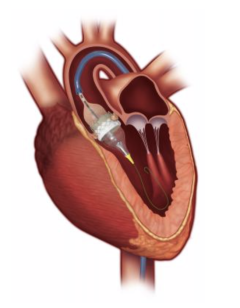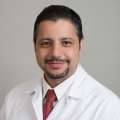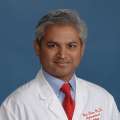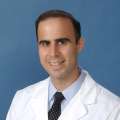Transcatheter Aortic Valve Replacement
Find your care
Interventional cardiology teams provide care in multiple locations. To learn more about our services, call 310-825-9011.
UCLA Health ranks as one of the top hospitals in the nation according to a U.S. News & World Report. Our cardiology and heart surgery program consistently ranks among the top in the nation.
What is Aortic Valve Stenosis?
Aortic valve stenosis is a form of heart disease in which the valve that regulates the flow of blood from the heart is prevented from opening fully. This can lead to chest pain or chest tightness, heart palpitations, fatigue and shortness of breath, especially with exertion.
While physicians have had great success in treating aortic valve stenosis by replacing the faulty valve with a mechanical one or a valve made from animal tissue, some patients have not been candidates for this procedure because they are not healthy enough for open-heart surgery. These patients may benefit from a new replacement valve that can be implanted through a small incision in the groin or between the ribs, eliminating the need for a large incision in the chest.
Transcatheter Aortic Valve Replacement Procedure

The U.S. Food and Drug Administration (FDA) approved the transcatheter aortic valve replacement (TAVR) for appropriate patients with aortic valve stenosis who are not candidates for open surgery to replace their natural aortic valve in 2011. This approval was extended to patients who are moderate risk for surgery in 2016 and finally to low risk patients 8/2019. Thus, currently all patients with severe aortic stenosis with symptoms may be eligible for TAVR as evaluated by the Heart Teams.
The TAVR procedure resembles a balloon angioplasty, in which a catheter - a long, flexible tube - is threaded through an artery and a balloon device on the end inflates to help open up a narrowing in an artery in the heart. In the case of TAVR, the replacement valve collapses to a very small diameter and is crimped onto the balloon device. The surgeon positions the replacement valve inside the patient's natural aortic valve and inflates the balloon. This causes the replacement valve to expand, pushing the faulty valve aside. The replacement valve begins to function as soon as the balloon catheter deflates to permit the flow of blood.
Patients usually enjoy immediate benefit from the procedure in terms of improved blood circulation. Because the replacement valve is placed using minimally invasive techniques, patients usually experience a much more rapid recovery than they would from a traditional, open-heart valve replacement.
Our Multidisciplinary Team Approach
The Heart Team at UCLA includes interventional cardiologists, non-invasive cardiologists, cardiothoracic surgeons, and anesthesiologists. UCLA has been performing TAVR since 2012 and has been leading the nation in enjoying excellent outcomes with the TAVR procedure. The team at UCLA has been performing TAVR with moderate sedation (as opposed to general anesthesia) since 2015 in a large majority of patients helping improve safety of the procedure. Using the newest generation devices, we have been using "transfemoral" access in the large majority of our patients; however the team also has extensive experience in alternative approaches including transaxillary, transapical approaches if needed. The UCLA team has led the nation in outcomes and has organized several conferences and seminars to teach best practices to visiting teams from around the nation and physicians from around the globe.
Listen to Dr. Aksoy talk about Aortic Stenosis and its treatment
What to Expect
Once patients are referred for evaluation, appointments are set to meet with the Cardiologist and the Surgeon on the same day at UCLA. Unless already obtained, a CT scan to evaluate for access and valve sizing is done the day of these appointments to optimize the visit. After thorough consultations and review of imaging, our Heart Team discusses each patient's case and recommends the best course of action. When TAVR is the recommendation, we then evaluate for need for coronary angiogram and also ask for dental clearance (dental infections are the most common sources of infections for heart valves). The date is then set for TAVR procedure depending on patient convenience.
On the day of TAVR, our patients check in at the hospital and after adequate preparation, TAVR procedure is performed. Patients are then monitored for valve function and medications are optimized. After patients are deemed to be stable for discharge, we arrange for 1 week, 1 month, and 1 year follow ups with echocardiograms.
UCLA is actively evaluating patients as candidates for TAVR. For more information or to arrange an evaluation, please call the appointments number below.
Contact Information
Jeanne Huchting, ACNP, UCLA TAVR Coordinator
Tel: (310) 825-9011
Fax: (310) 825-9012
Email: [email protected]






